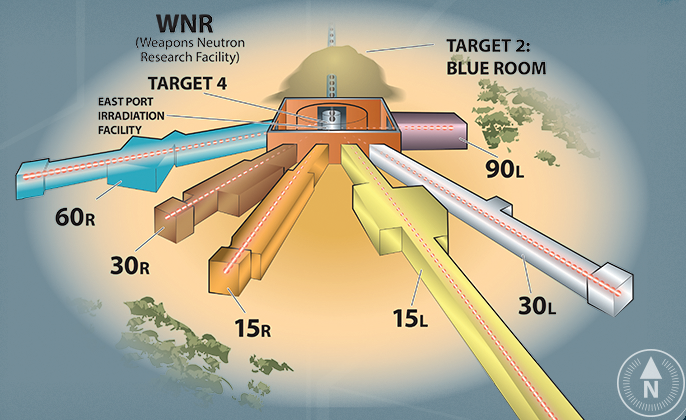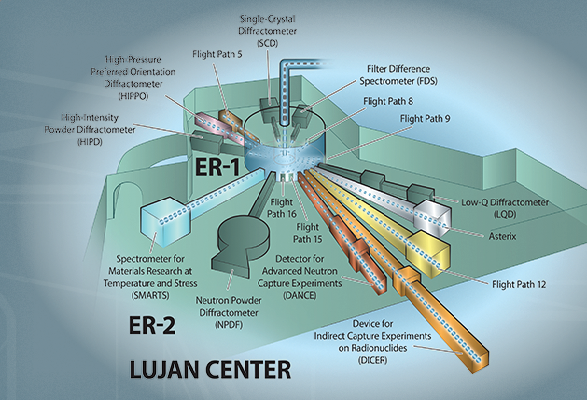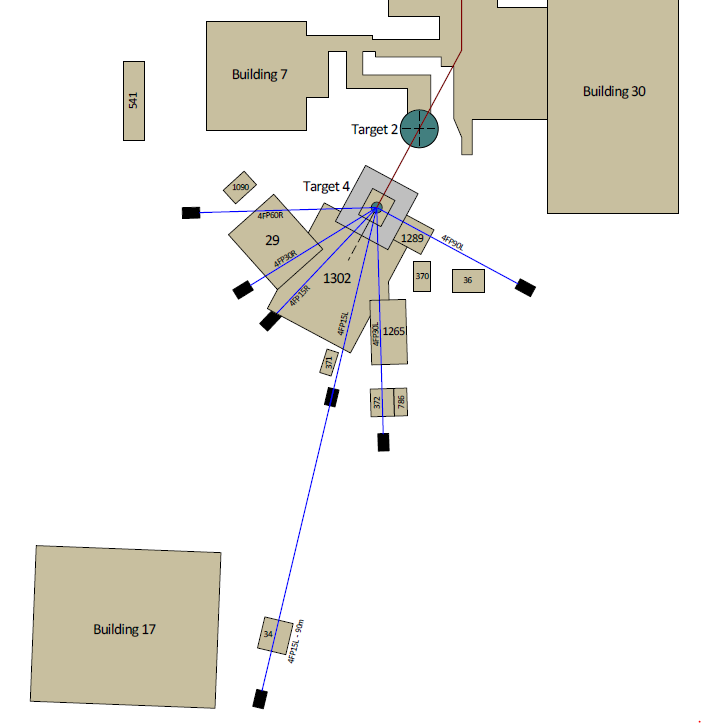Weapons Neutron Research Flight Paths
Overview of Flight Paths
Each flight path’s name identifies the target and the direction of the flight path (FP) with respect to the proton beam. For example, 4FP15R is a FP (flight path) that starts at Target 4 and is 15 degrees to the right (15R) of the incoming proton beam. The beams are transmitted at three different vertical levels: Target 4, Target 2, and Lujan Center (Target 1).



The layout of the flight paths at the LANSCE neutron sources.

A schematic drawing of the Target-2 and Target-4 flight paths.
The flight paths and the major research program that are on each flight path are briefly described below, and described in more detail by clicking on the individual flight path.
Target 4 Flight Paths
For the Target 4 flight paths, the neutron spectrum depends on the angle of the flight path with respect to the proton beam.

The calculated neutron spectra for various flight paths at Target 4.
As seen in this plot, the most forward angle flight paths at 15 degrees have the most intensity at high energy and somewhat lower intensity at lower neutron energy. The more backward angle flight paths at 90 degrees have significantly lower intensity at high energy and more intensity at lower energies. The flight paths at 30 and 60 degrees fit between those extremes. The shape of the neutron spectrum at the different flight path angles must be considered when choosing a flight path for a particular experiment.
- 4FP90L offers the softest spectrum of all WNR flight paths and is primarily used for-fission cross-section measurements. The length of the flight path is approximately 7 - 15 meters. Instruments used here have included fission chambers and a fission Time Projection Chamber (TPC). Researchers use the TPC to measure energy-differential neutron-induced fission cross-sections with unprecedented precision.
- 4FP30L or ICE House (Irradiation of Chips and Electronics) is located at a 30-degree flight path. At this angle, the shape of the neutron spectrum here is similar to that of neutrons produced in the atmosphere by cosmic rays. However, the neutron flux available at ICE House is a million times higher. This large flux enables testing of semiconductor devices at greatly accelerated rates.
- 4FP15L or CHI-NU uses neutrons produced at a 15-degree angle to the incident proton beam from the spallation source. 15L is unique among the flight paths because it has two experimental locations available at distances of 22 m and 90 m from the spallation target. A rectangular shutter offers variable openings, enabling researchers to choose flux intensity based on experimental requirements. The beam shape can be changed by inserting collimator inserts into the neutron beam tube. A 2-meter-deep pit is located below the raised floor of a 22-meter experimental location, reducing the room-return neutron background for experiments. This flight path is primarily used for Chi-Nu experiments (22 m) and neutron detector development and calibration (90 m).
- 4FP15R offers the hardest neutron spectrum available at WNR, with neutron energies extending to 800 MeV. The neutron beam size is adjustable up to 5 cm by 5 cm square. Present research efforts include precision measurements of neutron-induced charged particle reactions using the Low-Energy NZ (LENZ) instrument on stable and radioactive samples. Applications are nuclear reaction studies, nuclear astrophysics, radiochemical diagnostics, and materials for next-generation nuclear reactors.
- 4FP30R or ICE II, is built like ICE House and is also used to test semiconductor devices at greatly accelerated rates. lCE II offers slightly higher neutron flux as compared with ICE House due to shorter flight path length. Companies from around the world use this neutron source to characterize components and study various failure modes caused by neutron radiation.
- 4FP60R Unique high-energy neutron imaging has been developed to penetrate dense, thick objects for defense program needs. Both radiography and computed tomography (CT) are used to visualize internal features of a variety of objects. The neutron beam's field of view ranges from 30 cm by 20 cm to 2.5 cm in diameter. Imaging detector systems include fast (nanosecond) time-of-flight gated cameras that provide neutron energy selection within the available energy range of 0.1 to 400 MeV and large flat-panel arrays that cover the full field of view.
Target 2 (Blue Room)
- Target 2 is used for proton beam irradiation experiments. Beam is available directly from the linac or from the proton storage ring (PSR).Typical operation is at 800MeV. For cases with sufficient justification, beam energies as low as 113 MeV are possible. Experiments include proton irradiation of detector materials for the MaRIE project, the Large Hadron Collider, and space radiation environment studies. The Lead Slowing-Down Spectrometer (LSDS) is used for measuring neutron reaction cross sections with ultra-small samples.
Lujan Center Flight Paths
- FP5 uses thermal neutrons from the 1L target to provide 1 MeV to 1 keV for nuclear physics measurements and approximately 1 MeV to 100 eV for energy-resolved neutron imaging. End stations at 8 and 60 m are available for a variety of experiments, such as imaging with beam spot sizes 1 mm to 1 m in diameter. Experiments conducted on this flight path include neutron radiography and tomography, particularly, three-dimensional isotope concentration measurements using neutron absorption resonances. This flight path is also used for detector development.
- FP14 a 4π detector array, DANCE (Detector for Advanced Neutron Capture Experiments) consists of 160 barium fluoride crystals. It is designed to study neutron-capture reactions on small quantities of radioactive isotopes (down to 1 mg and up to 1 Ci). Applications include nuclear astrophysics, radiochemical diagnostics, and science to bolster stockpile stewardship. DANCE can also be used to study gamma-ray emissions following fission.
- FP12 uses cold neutrons from the 1L target. A liquid mercury shutter controls the transmission of the neutron beam from the target. The flight path views the partially coupled cold hydrogen moderator, with an installed neutron guide used to enhance the transport of cold neutrons to the sample position. This multi-use flight path accommodates a variety of experiments that require a cold neutron spectrum.
- FP13 currently under development, the Device for Indirect capture Experiments on Radionuclides (DICER) will measure neutron total cross sections for very small radioactive samples. Obtaining such data will enable researchers to tightly constrain neutron-capture cross sections for radionuclides of great importance to applications such as radiochemical diagnostics, nuclear forensics, and nuclear astrophysics.

